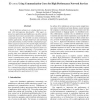ISLPED
2005
ACM
14 years 6 months ago
2005
ACM
As the number of cores on a chip increases, power consumed by the communication structures takes significant portion of the overall power-budget. The individual components of the...
WORDS
2005
IEEE
14 years 6 months ago
2005
IEEE
Depending on the physical structuring of large distributed safety-critical real-time systems, one can distinguish federated and integrated system architectures. This paper investi...
NCA
2005
IEEE
14 years 6 months ago
2005
IEEE
Recent hardware advances are creating multi-core systems with heterogeneous functionality. This paper explores how applications and middleware can utilize systems comprised of pro...
ISPDC
2005
IEEE
14 years 6 months ago
2005
IEEE
We propose a method for coordinating local components that observe a distributed discrete-event system R and execute actions depending on the current state of R. Coordination is a...
ISPDC
2005
IEEE
14 years 6 months ago
2005
IEEE
Zero-copy communication exchanges the messages among the buffers that are allocated and locked before the communication itself. This communication style fits into applications th...
ISCC
2005
IEEE
14 years 6 months ago
2005
IEEE
A shared communication medium is characterized by multiple entities that use this medium by reading and writing from and to it. Write operations on the shared communication medium...
ISCAS
2005
IEEE
14 years 6 months ago
2005
IEEE
Abstract — Mapping applications onto different networks-onchip (NoCs) topologies is done by mapping processing cores on local ports of routers considering requirements like laten...
IEEEPACT
2005
IEEE
14 years 6 months ago
2005
IEEE
Hiding communication latency is an important optimization for parallel programs. Programmers or compilers achieve this by using non-blocking communication primitives and overlappi...
IAT
2005
IEEE
14 years 6 months ago
2005
IEEE
Choosing when to communicate is a fundamental problem in multi-agent systems. This problem becomes particularly hard when communication is constrained and each agent has different...
DATE
2005
IEEE
14 years 6 months ago
2005
IEEE
Complex applications implemented as Systems on Chip (SoCs) demand extensive use of system level modeling and validation. Their implementation gathers a large number of complex IP ...




